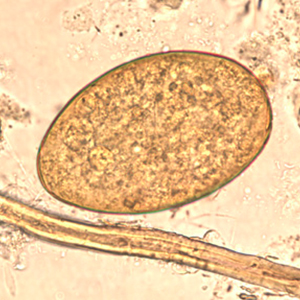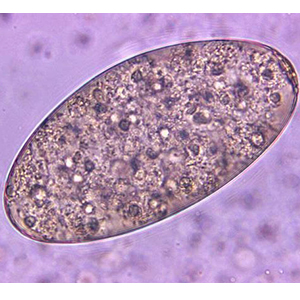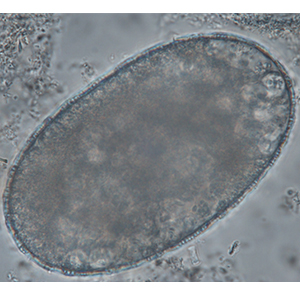Fasciolopsis buski is a trematode belonging to the Fasciolidae family. It affects the stomach and duodenum of suids, dogs, rabbits, and non-human primates (Garcia, 2021).
Epidemiology
Fasciolopsis buski can be found in China and South-East Asia. It has been reported in Old World Monkeys, namely rhesus macaques (Macaca mulatta) (Garcia, 2021; Islam et al., 2022).
Description
Fasciolopsis buski eggs are operculated and large (130-140 µm long and 80-85µm large). Their content is granulomatous (Garcia, 2021).
Differential diagnosis
Differential diagnosis includes other trematode eggs of non-human primates, namely Gastrodiscoides hominis and Fasciola hepatica, as well as mite eggs. Differentiation requires larva visualization after coproculture (Garcia, 2021). Mite eggs are of similar dimensions as trematode eggs. They are easy to identify when mature as embryos are clearly visible. However, differentiation is more difficult when the egg is immature (Petithory et al., 1995).
Clinical significance
Infection by Fasciolopsis buski is normally asymptomatic. In case of massive parasite load, it can cause liquid, yellowish and malodorous diarrhea, and lead to intestinal occlusion. It is important to note that Fasciolopsis buski is zoonotic and can cause disease in humans (Mehlhorn, 2015).
Prophylaxis and treatment
As Fasciolopsis buski is zoonotic, hygienic measures need to be taken in case of diagnosis, notably due to the fact that environmental treatment can prevent the development of the parasite by blocking its life cycle. Prophylaxis should center on the prevention of the development of plants in which the larvae (metacercaria) can develop (Mehlhorn, 2015; Garcia, 2021).
In humans, praziquantel (15 mg/kg), niclosamide and tetrachloroethylene are indicated to treat this parasitosis. In non-human primates, praziquantel (30 mg/kg PO) seems to also be effective (Mehlhorn, 2015).
Zoonotic transmission of this parasite does not occur in zoological park, as human contamination requires the ingestion of fresh aquatic plants on which the metacercarial forms of the parasite reside.






